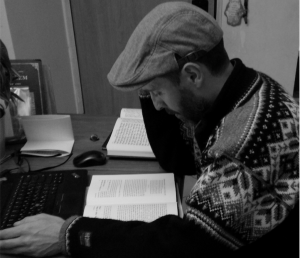Veiling the Conveyance of God
The urge to know the Divine without the mediation of words or prophets, traditional texts or individuals sanctioned by tradition with the duty to channel God’s word to the people, is a well- known fact in Western tradition. Between Plato’s allegory of the cave and the Pauline statement for an unveiled perception of truth in 1 Cor. 13:12, the Torah proposes a different model, for which the desire for immanence and the immediacy of communion with God is a prerogative of Moses alone, and not for the people as a whole. The veiling of Divine immanence is, so to speak, a precondition for the human interaction with God – the signification of Divine truth is always partial, necessarily veiled.
Exodus 34: 30-35
Aaron and all the Israelites saw that the skin of Moses’ face was radiant; and they shrank from coming near him.
But Moses called to them, and Aaron and all the chieftains in the assembly returned to him, and Moses spoke to them.
Afterward all the Israelites came near, and he instructed them concerning all that the LORD had imparted to him on Mount Sinai.
And when Moses had finished speaking with them, he put a veil over his face.
Whenever Moses went in before the LORD to speak with Him, he would leave the veil off until he came out; and when he came out and told the Israelites what he had been commanded,
the Israelites would see how radiant the skin of Moses’ face was. Moses would then put the veil back over his face until he went in to speak with Him.
The radiance of Moses’ face represents, in a way, the intensity and proximity between the prophet as the signifier of Divine truth, and the Godly signified which he represents to the people. This proximity is a prerogative of one individual alone – the intensity of this connection is characteristic of only one agent, whose visage becomes the radiating expression of Divine meaning. Yet this intensity is incompatible with the spreading of that Divine intention to the people – not only because the Israelites fear Divine truth and the visual appearance it takes – but rather because tradition relies on that veil. For there to be a tradition, for there to be a translation of the immediacy of Divine utterance into the dispersion of human language, there MUST be the veiling of truth. Unlike in other traditions, the Jewish canon presents the mediation not as a device conceived to correct the cognitive imperfection of the fallen human being – revelation is always already mediated, or, to put it otherwise, revelation is mediation, immediacy is mediation, and immanence is transcendence.
As William Kolbrener has argued in his “The Hermeneutics of Mourning: Multiplicity and Authority in Jewish Law” College Literature 30.4 (2003) 114-139:
On a superficial reading, the Old Testament text itself might seem to cultivate the possibility of the very unmediated access to the divine which Paul would later celebrate as uniquely Christian-the revelation of God in something like his ontological fullness. To be sure, the desire for such a revelation is inscribed in Moses’ own request to God-“Show me Thy Glory” (Exodus 33.18)-but the verses that follow demonstrate that this possibility is itself refused. Indeed the passage which ostensibly describes such Mosaic access to the divine, Exodus 33:11-“So the Lord spoke to Moses face to face”-is followed at the end of the chapter, by what appears to be a contradiction, or at the very least a qualification of the preceding verse: “Then I will take away My hand, and you shall see My back, but My face shall not be seen.” The Targum Onkelos (the second century Aramaic translation of the Five Books of Moses), resolving this apparent contradiction between the two verses, translates the first of them against the grain of a literalism which would attribute to Moses an unmediated knowledge of God: Onkelos renders “face to face” [panim el’panim in the Hebrew] in Aramaic as m’lal l’m’lal, or “words to words.” Onkelos thus insists that even the revelation to Moses was one that was mediated through “words.” The “veil of textuality,” the insistent mediation of language is not, in Targum Onkelos side-stepped, or even apologetically defended, but rather aggressively professed.
Against a constellation of Western traditions which crave, as Hilary Putnam has written, access to the “God’s-Eye View,” the rabbinic tradition has consistently constituted itself through the discursive. What Putnam argues in a paraphrase of Austin can surely be applied to the rabbis: “though enough isn’t everything, enough is enough” (1990, 170). Though there is no possibility of a recuperation of truth in its totality, language, even ordinary language, can nonetheless get things “right”: “enough” may not be everything; but “enough” nevertheless, suffices. Abandoning-indeed never entertaining-the dream of unmediated presence, the rabbis demonstrate that language, notwithstanding all of its limitations, is enough.
Instead of Kolbrener’s very clear argument in favor of “the hermeneutics of mourning” or “enough is enough,” I would like to argue that the immediate presence entails a mediated expression / manifestation, as the urge of the totality of truth is always already frustrated by the partiality of its re-presentation.
*Yaakov Mascetti holds a Ph.D. and teaches at the Department of Comparative Literature, Bar Ilan University.

